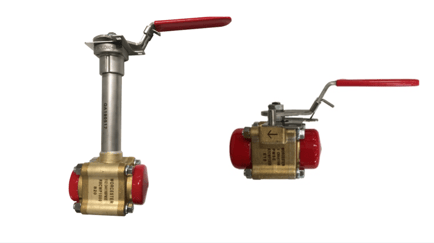By: Lance Looper on June 7th, 2023
Preventing Pressure Drops & Cavitation in Positive Displacement Systems
Positive displacement systems can be found across a broad range of industries where accurate and precise fluid or gas transfer or pumping is imperative. In the simplest of terms, a positive displacement system displaces a specific quantity of liquid for every revolution or cycle that a pump completes. The flow rate is directly proportional to the speed and number of pump cycles over a given time.
When it comes to cryogenics and compressed gas, you can find positive displacement systems in applications that touch just about every part of everyday life:
- Food and Beverage: Beverage carbonation production, bottling plants and frozen food plants use positive displacement pumping systems to ensure food and beverage quality.
- Industrial Gas: The production, distribution and storage of industrial gases like nitrogen, oxygen, helium, argon and hydrogen commonly use positive displacement pumping systems for transfer, cylinder filling, pipeline purging and maintaining gas supplies.
- Cryogenics: Cryogenic storage, transportation and research all use positive displacement systems for liquid forms of nitrogen, oxygen, helium and natural gas to fill cryogenic dewars, cryostats or cooling systems.
- Semiconductor Manufacturing: Specialty gases are required for manufacturing semiconductors, so pumping systems are necessary to control delivery for high-purity nitrogen, argon, hydrogen and others.
- Medical and Healthcare: Positive displacement pumps are used in medical facilities for cryogenic applications such as storing and transferring liquid oxygen, liquid nitrogen and medical-grade nitrogen, as well as maintaining a reliable supply of cryogenic fluids for medical procedures, laboratories and cryo-preservation.
- Research and Laboratories: Labs and research facilities need positive displacement systems to manage gases for experiments, sample preservation and cooling applications.
- Energy and Power Generation: Natural gas and hydrogen are used in some power plants, with positive displacement pumps handling their transfer and circulation.
- Aerospace and Defense: Positive displacement pumps play key roles in rocket propellant handling, fueling systems, and more.
What can go wrong?
Positive displacement systems rely on constant pressure and flow for the system to operate smoothly and safely. Drops in pressure can cause cavitation, which will ultimately wear out the pump and cause it to fail. Cavitation refers to the formation and collapse of vapor bubbles within a liquid due to a rapid drop in pressure, which leads to pitting and pump wear.
Pressure drops and cavitation lead to a domino effect that eventually wears out the pump:
- Pressure drop: When the pressure drops, usually due to a restriction or sudden change in the system, the liquid in the pump’s suction side experiences a decrease in pressure.
- Formation of vapor bubbles: The decreased pressure causes the liquid to vaporize, forming small vapor bubbles within the liquid.
- Bubble collapse: As the liquid flows from low to high pressure, the vapor bubbles collapse or implode due to the increased pressure. This implosion creates localized shockwaves and intense forces within the liquid.
- Damage to pump components: The implosion of vapor bubbles near the pump’s impeller or other components can cause significant damage. The shock waves generated during bubble collapse can erode or pit the surfaces of the pump’s impeller, casing and other components. Over time, this erosion and pitting leads to wear, reduced performance, and eventually, pump failure.
What can you do?
The best prevention is to design the system with the proper considerations to prevent pressure drops, and thus prevent cavitation from wearing out the pump.
- Pressure control: Maintain stable and appropriate pressure levels within the system by using pressure regulators, control valves, or other devices.
- Suction conditions: Ensure that the pump’s suction side is not subject to excessive restrictions or pressure drops, such as by using properly sized pipes, avoiding sharp bends, and minimizing obstructions.
- Pump selection: Choose a pump specifically designed to handle potential cavitation conditions. Some pumps have features like inducers or special impeller designs that can help mitigate cavitation effects.
- Materials and coatings: Select materials and coatings for pump components that can withstand the erosive forces caused by cavitation.

Prevent cavitation and catastrophic pump failure with the Worcester C44 Ball Valve.
The Worcester C44 Ball Valve by Flowserve is an industry standout for its unique design and vent that prevents pressure drops and cavitation. Preferred by NASA, major gas companies and food and beverage giants, the C44 Ball Valve is considered the ‘Cadillac’ valve of the industry for the following reasons:
- Positive ball cavity relief: An upstream relief hole in the ball prevents dangerous overpressure due to thermal expansion. On extended stem valves (up to two inches), a one-piece stem with alignment pin assures proper orientation of the ball.
- Pressure safe stem: Both one-piece and two-piece, assembled-inside-the-body stems are safe from blowout and are supported with Polyfill thrustwashers.
- Zero leak packing: Belleville live-loaded TFE packing rings and stem centering followers assure zero leakage through the toughest, high-cycle applications.
- Effective bonnet extensions: The stem extensions of Worcester Controls’ cryogenic valves conform to standard industrial practices–meaning wall thickness and lengths that keep heat transfer down, the packing frost-free, operational torques low, and actuators solidly supported.
- High-performance / low-thermal stress: The special part compatibility design of valve parts, Polyfill seats and body seals assure tight shutoff, zero body leakage and low torque through large thermal excursions from ambient to -425℉.
- Designed for automation: Approximately 40% of cryogenic installations require fail-safe operation or automatic on/off control. Worcester Controls has the pneumatic and electronic, computer-compatible controls for those installations.
- Custom option for fire safety: A Series 94 double-graphite, stem-sealed fire-tight version of the cryogenic valve is available as a custom option. These valves are especially effective in hydrogen and liquefied natural gas systems.
Shop Worcester C44 Ball Valves for Cryogenic Service at Ratermann.


